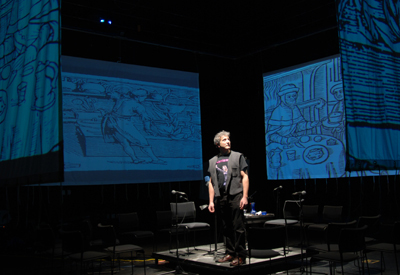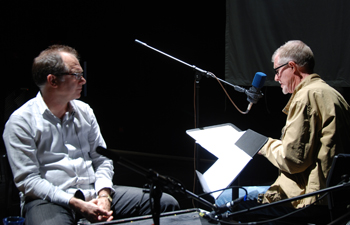Channels and Back-channels: An Interactive Web Environment to Complement TV Broadcast
San Diego, Aug. 1, 2011 -- Millions of Americans use their laptops while also watching their favorite primetime programs, and increasingly TV networks are inviting viewers to visit the program’s website to engage them more fully in the episode. Now a university-based TV channel is teaming with campus researchers to demonstrate a real-time interactive site that pushes parallel audience participation in TV programming to a new level.
|
“Our interactive website will play in synch with the TV broadcast to give the audience a sense of replicating the shared experience of the audience in the theater where the original performance took place,” said UC San Diego music professor Shlomo Dubnov. “This will create a unique combination of TV and the web for public engagement, and over time we intend to expand the features available to viewers.”
UCSD-TV will premiere Kamza and Bar Kamza, produced by Dubnov and Calit2, based on the original performance of Dubnov’s innovative theatrical piece for multiple media in 2008. That performanceinvited the live audience to engage with the performers to debate and comment on the Kamza and Bar Kamza parable from the Talmud about the destruction of the temple and fall of Jerusalem in the 1st century C.E.
The first showing of the TV program coincides with Tisha B’Av, the Hebrew day of mourning to commemorate the destruction of Jerusalem. This year it falls on August 9. Noted Dubnov: “The story of Kamza and Bar Kamza is part of the traditional discussion that takes place in many observant homes on the day of Tisha B’Av.”
|
“The original performance at Calit2 and a subsequent performance in UCSD’s Loft performance space allowed the audiences to speak up or participate via the Internet,” said Dubnov, who directs the Center for Research in Entertainment and Learning (CREL) at Calit2. “When UCSD-TV agreed to air the program, we decided that it was important to engage TV audiences in a similar way, with a heavy emphasis on enabling back-channel communications among viewers who are watching the program at the same time.”
During the broadcast premiere of Kamza and Bar Kamza on UCSD-TV, and in subsequent re-broadcasts into the fall (see dates and times below), viewers will be able to watch the program on TV and simultaneously participate in live chats with other viewers, respond to poll questions, navigate to relevant sites on the Internet, and view images and text on their laptop? computer screen that were originally projected on large screens surrounding the Calit2 Theater audience. The interactive site will also pull content in real time from the Internet to create a mash-up of content ranging from Flickr images to Google Maps and other web content.
According to UCSD’s Dubnov, interactivity and the web are ideally suited to delving into the story of Kamza and Bar Kamza. “This type of program needs to be discussed,” he said, “not just watched.”
The traditional interpretation of the story blames the destruction of the temple on a mistaken identity and personal quarrel between two men with similar names, Kamza and Bar Kamza. In the traditional text, written in the Talmudic method of a central story and surrounding commentaries, various rabbis raised questions about the leadership’s responsibility, about the way the conflict with the Romans was negotiated, and eventually even about God’s role.
To engage the audience fully, Kamza and Bar Kamza invites the audience to watch the performers to learn more and join the debate over the Internet. The TV program features pre-recorded interviews with scholars who explore conflict resolution, rationality, guilt, religion and so on. The performance is told in four acts, each focusing on specific themes; during these scenes on TV, the website will dynamically refresh its content by pushing pertinent information to visitors about the themes discussed in that act.
“Viewers will be able to navigate away from the site, or engage with information that we ‘push’ onto the page, allowing them to immerse themselves in information related to the topics even as they are being discussed during the original performance,” said Dubnov. “So this is about creating an audience dialogue and also tapping into the ‘silent conversation’ in the heads of audience members. In some sense it is about reviving old practices of exegesis – exploring the meaning of the Bible and other texts – but presented through a combination of modern learning and entertainment technologies.”
The performance program Kamza and Bar Kamza will premiere on August 9 at 8 p.m. on UCSD-TV Viewers can participate in the online conversation during all five airings in August on UCSD-TV (all times Pacific):
Tuesday, August 9, 8 p.m.
Thursday, August 11, 10 p.m.
Sunday, August 14, 10 p.m.
Friday, August 19, 9 p.m.
Monday, August 22, 7 p.m.
Watch UCSD-TV in San Diego on Cox and Time Warner Ch. 135, Time Warner Del Mar Ch. 19, AT&T Uverse Ch. 99, and UHF (no cable) Ch. 35. Video archives, podcast downloads, broadcast schedules and more are available online at www.ucsd.tv.
Related Links
Kamza and Bar Kamza Online
Center for Research in Entertainment and Learning
Media Contacts
Doug Ramsey, 858-822-5825, dramsey@ucsd.edu



